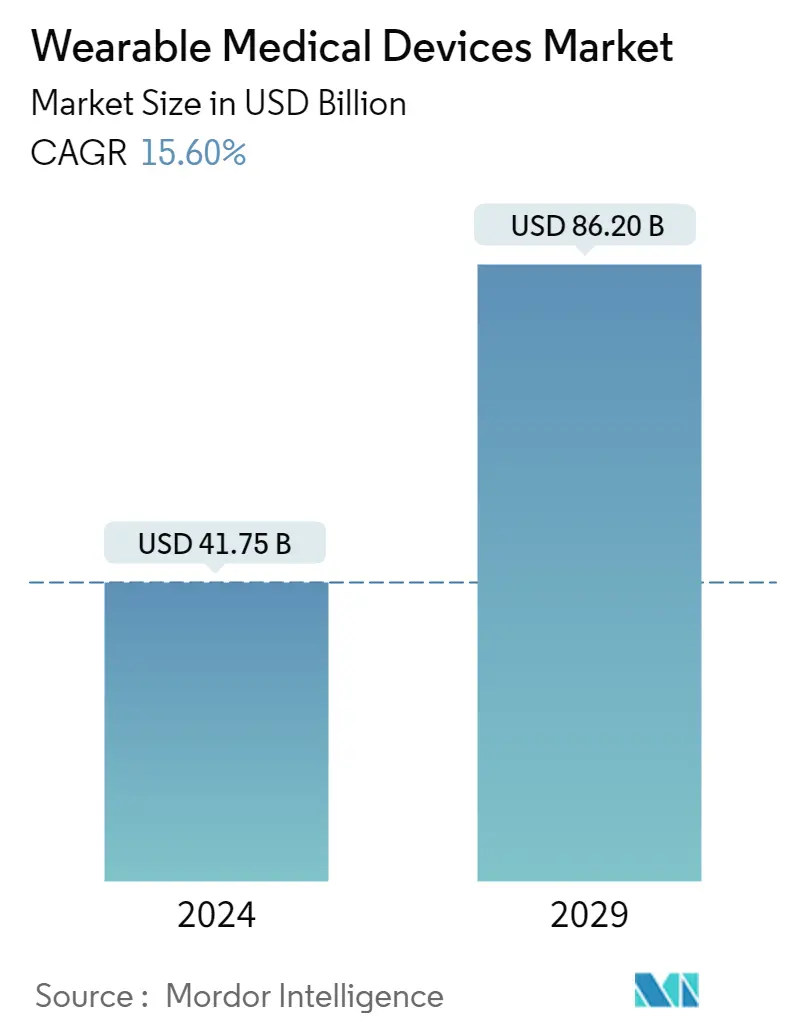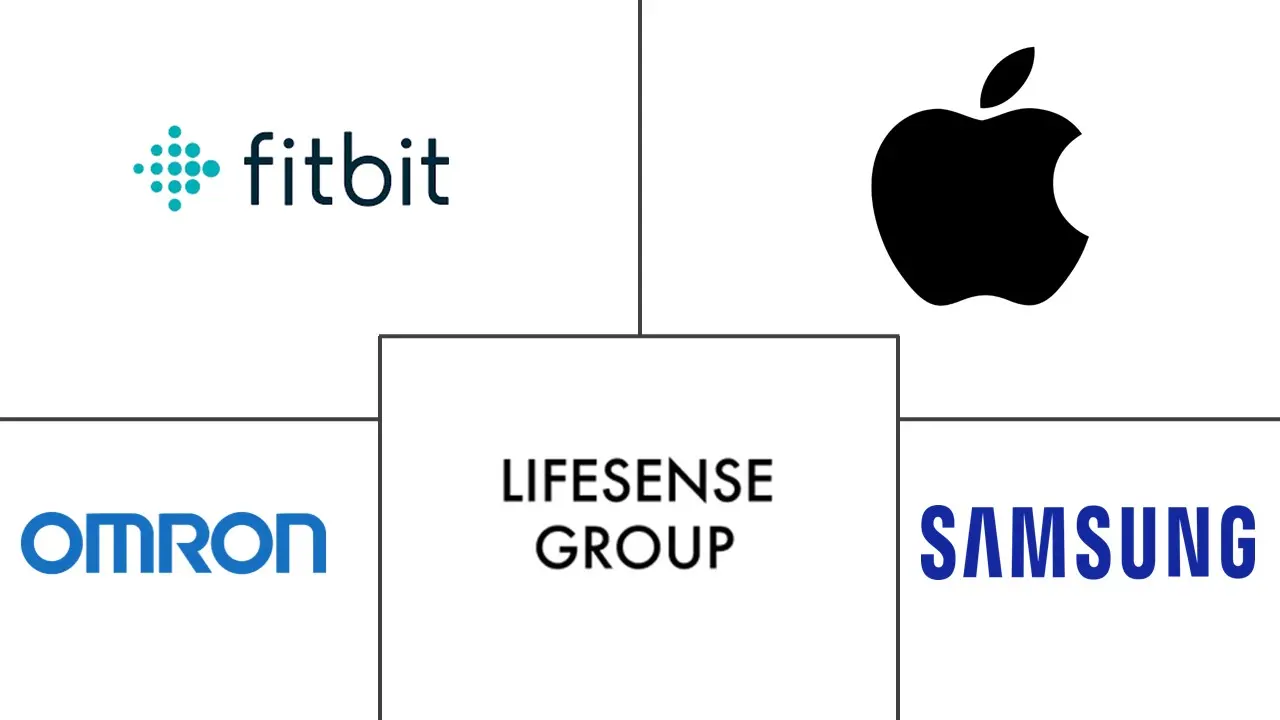
| Study Period | 2021 - 2029 |
| Market Size (2024) | USD 41.75 Billion |
| Market Size (2029) | USD 86.20 Billion |
| CAGR (2024 - 2029) | 15.60 % |
| Fastest Growing Market | Asia Pacific |
| Largest Market | North America |
| Market Concentration | Low |
Major Players
*Disclaimer: Major Players sorted in no particular order |
Wearable Medical Devices Market Analysis
The Wearable Medical Devices Market size is estimated at USD 41.75 billion in 2024, and is expected to reach USD 86.20 billion by 2029, growing at a CAGR of 15.60% during the forecast period (2024-2029).
Wearable devices play a crucial role in predicting certain disorders by integrating essential vital signs with clinical symptomology. The use of wearable devices in a bid to combat COVID-19 has therefore been ramped up. Research has recently expanded on whether the extensive data that wearable devices collect can predict the onset of the virus or not.
For instance, according to a study published in NCBI in July 2022, 22 distinct types of wearable technology devices, such as smartwatches or fitness trackers, medical devices, and others, are utilized to identify COVID-19 infections. Such a huge adoption of wearable medical devices during the pandemic has been expected to drive market growth. Furthermore, post-pandemic, the market is expected to drive swiftly due to the rise in the adoption of wearable devices to track key health indicators.
The wearable medical devices market is growing at a faster pace owing to the rising technological innovations and advancements, as they can improve the lifestyle of the general population as well as the patient population. Wearable technologies offer a convenient mode of monitoring physiological symptoms, featuring a multitude of medical solutions. These devices are not only easy for consumer use but also offer real-time data for physicians to analyze. From the Apple Watch's EKG capabilities to new continuous glucose monitoring systems, wearable medical technologies have a broad range of potential applications in the healthcare industry.
The rise in the launch of wearable devices by the key market players is expected to propel market growth due to the rise in the adoption of such devices to monitor key health indicators. For instance, in August 2022, GOQii launched Smart Vital Ultra and GOQii Stream devices targeted at young adults and youth. These two products help enable consumers to monitor their vitals with ease.
Also, fundraising by companies to adopt innovative technologies such as implementing artificial intelligence (AI) technology in a wearable device to measure vital signs are anticipated to drive the market growth over the forecast period due to the rise in adoption of the technologically advanced product. For instance, in February 2022, Respira Labs closed a USD 2.8 million financing round to continue developing and manufacturing its chest wearable that uses acoustic resonance to assess lung function and identify changes in lung air volume, which is especially important for COPD, COVID-19, and asthma patients.
However, factors such as the lack of awareness about the availability of some wearable devices in developing and underdeveloped countries and the high cost of wearable devices are some of the major challenges to the growth prospects of the market.
Wearable Medical Devices Industry Segmentation
As per the scope of the report, wearable medical devices are autonomous devices capable of diagnosing or monitoring medical conditions combined with digital health information, typically worn over the body. These devices possess features such as noninvasive physiological sensors, data processing modules, medical feedback, and wireless data transmission capabilities. The Wearable Devices Market is Segmented by Device Type (Diagnostic Devices (Vital Sign Monitoring Devices, Sleep Monitoring Devices, Electrocardiographs Fetal and Obstetric Devices, Neuromonitoring Devices) and Therapeutic Devices), Application (Sports and Fitness, Remote Patient Monitoring, and Home Healthcare), Product Type (Watch, Wristband, Ear Wear, and Other Product Types), and Geography (North America, Europe, Asia-Pacific, Middle East and Africa, and South America). The report offers the value (in USD million) for the above segments. The market report also covers the estimated market sizes and trends for 17 different countries across major regions globally. The report offers the value (in USD million) for the above segments.
| Diagnostic Devices | Vital Sign Monitoring Devices |
| Sleep Monitoring Devices | |
| Electrocardiographs Fetal and Obstetric Devices | |
| Neuromonitoring Devices | |
| Therapeutic Devices | Pain Management Devices |
| Rehabilitation Devices | |
| Respiratory Therapy Devices | |
| Other Therapeutic Devices |
| Sports and Fitness |
| Remote Patient Monitoring |
| Home Healthcare |
| Watch |
| Wristband |
| Ear Wear |
| Other Product Types |
| North America | United States |
| Canada | |
| Mexico | |
| Europe | United Kingdom |
| Germany | |
| France | |
| Italy | |
| Spain | |
| Rest of Europe | |
| Asia-Pacific | China |
| Japan | |
| India | |
| Australia | |
| South Korea | |
| Rest of Asia-Pacific | |
| Middle East and Africa | GCC |
| South Africa | |
| Rest of Middle East and Africa | |
| South America | Brazil |
| Argentina | |
| Rest of South America |
Wearable Medical Devices Market Size Summary
The wearable medical devices market is experiencing significant growth, driven by technological advancements and the increasing adoption of these devices to monitor health indicators. These devices, which include smartwatches and fitness trackers, play a vital role in predicting disorders by integrating vital signs with clinical symptomology. The COVID-19 pandemic accelerated the adoption of wearable devices, as they were utilized to identify infections and monitor health metrics. This trend is expected to continue post-pandemic, with wearable devices becoming more prevalent in tracking key health indicators. The market is further propelled by the launch of innovative products by key players and the integration of advanced technologies like artificial intelligence to enhance functionality and user experience.
North America is anticipated to hold a significant share of the wearable medical devices market, with the United States being a major contributor due to its high prevalence of cardiovascular and lifestyle-related diseases. The region benefits from the strong presence of major players and increased healthcare expenditure, which supports the development and adoption of innovative wearable technologies. The market is characterized by fragmentation, with numerous players introducing new products and solutions. Despite challenges such as high costs and limited awareness in developing regions, the market is poised for growth, driven by the rising demand for remote patient monitoring devices and the increasing prevalence of chronic diseases globally.
Wearable Medical Devices Market Size - Table of Contents
1. MARKET DYNAMICS
- 1.1 Market Overview
-
1.2 Market Drivers
- 1.2.1 Increasing Technological Advancements and Innovations
- 1.2.2 Increasing Per-capita Income in Developing Countries
- 1.2.3 Ease-of-use and Interpretation of Medical Devices
-
1.3 Market Restraints
- 1.3.1 High Cost of Wearable Devices
- 1.3.2 Unfavorable Reimbursement Issues
- 1.3.3 Lack of Awareness in Some Regions
-
1.4 Porter Five Forces
- 1.4.1 Threat of New Entrants
- 1.4.2 Bargaining Power of Buyers/Consumers
- 1.4.3 Bargaining Power of Suppliers
- 1.4.4 Threat of Substitute Products
- 1.4.5 Intensity of Competitive Rivalry
2. MARKET SEGMENTATION (Market Size by Value - USD million)
-
2.1 By Device Type
- 2.1.1 Diagnostic Devices
- 2.1.1.1 Vital Sign Monitoring Devices
- 2.1.1.2 Sleep Monitoring Devices
- 2.1.1.3 Electrocardiographs Fetal and Obstetric Devices
- 2.1.1.4 Neuromonitoring Devices
- 2.1.2 Therapeutic Devices
- 2.1.2.1 Pain Management Devices
- 2.1.2.2 Rehabilitation Devices
- 2.1.2.3 Respiratory Therapy Devices
- 2.1.2.4 Other Therapeutic Devices
-
2.2 By Application
- 2.2.1 Sports and Fitness
- 2.2.2 Remote Patient Monitoring
- 2.2.3 Home Healthcare
-
2.3 By Product Type
- 2.3.1 Watch
- 2.3.2 Wristband
- 2.3.3 Ear Wear
- 2.3.4 Other Product Types
-
2.4 By Geography
- 2.4.1 North America
- 2.4.1.1 United States
- 2.4.1.2 Canada
- 2.4.1.3 Mexico
- 2.4.2 Europe
- 2.4.2.1 United Kingdom
- 2.4.2.2 Germany
- 2.4.2.3 France
- 2.4.2.4 Italy
- 2.4.2.5 Spain
- 2.4.2.6 Rest of Europe
- 2.4.3 Asia-Pacific
- 2.4.3.1 China
- 2.4.3.2 Japan
- 2.4.3.3 India
- 2.4.3.4 Australia
- 2.4.3.5 South Korea
- 2.4.3.6 Rest of Asia-Pacific
- 2.4.4 Middle East and Africa
- 2.4.4.1 GCC
- 2.4.4.2 South Africa
- 2.4.4.3 Rest of Middle East and Africa
- 2.4.5 South America
- 2.4.5.1 Brazil
- 2.4.5.2 Argentina
- 2.4.5.3 Rest of South America
Wearable Medical Devices Market Research FAQs
How big is the Wearable Medical Devices Market?
The Wearable Medical Devices Market size is expected to reach USD 48.26 billion in 2025 and grow at a CAGR of 15.60% to reach USD 99.63 billion by 2030.
What is the current Wearable Medical Devices Market size?
In 2025, the Wearable Medical Devices Market size is expected to reach USD 48.26 billion.


